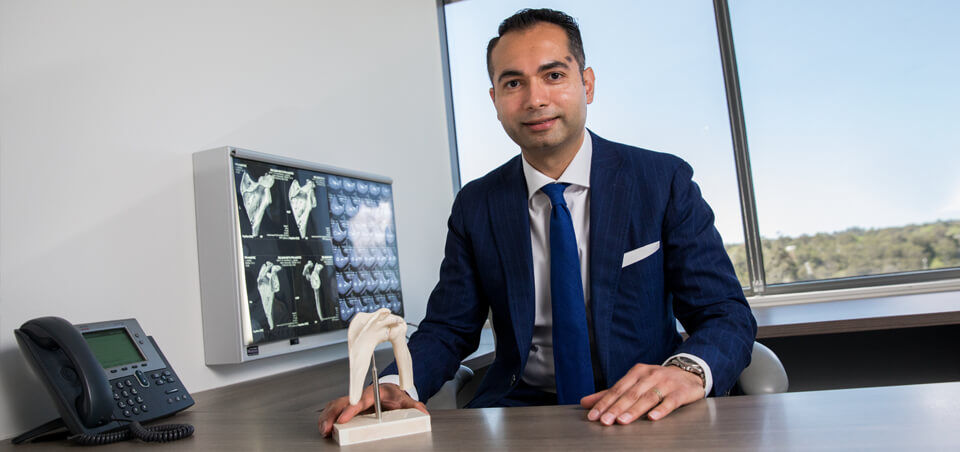Acromioclavicular Joint (ACJ) Arthritis
Knowledge that empowers
What is acromiclavicular joint arthritis?
The acromioclavicular (AC) joint is comprised of the acromion (the uppermost part of the shoulder blade) and the clavicle (collarbone)
Cartilage covers each end of the joint and it is supported by a group of ligaments that provide stability. The joint acts as a pivot point and helps transfer load between the arm and the body. Arthritis is wear and tear of the joints cartilage, which can be painful in some people due to bone-to-bone grinding.

Who is affected?
The AC joint can become arthritic for a number of reasons:
It can be related to wear and tear over time. The AC joint can show signs of degeneration as early as our 30’s; however it is more common by the time we reach our 60’s.
It is more common in those who participate in overhead sports (throwers; swimmers) or those who work overhead.
It can be related to trauma. This can affect anyone who has had an injury to the AC joint. The initial injury may have recovered but alteration to the normal joint surfaces or mechanics of the acromioclavicular joint may predispose someone to developing arthritis at an earlier age than is considered normal.
It can be related to inflammatory diseases such as rheumatoid arthritis as well.
What are the symptoms?
As discussed above, AC joint arthritis can be a normal sign of ageing in the shoulder and it is not something that always causes pain.
That being said, those who have symptomatic arthritis (evidence of arthritis on a scan with associated discomfort) often report pain that is felt on the top of the shoulder joint which can also spread upwards towards the neck.
This pain may be worse with movement such as overhead motion, reaching across your body or up behind your back. Those who regularly go to the gym might find push ups and bench press are painful due to the compressive forces on the joint. These same painful movements may also cause a clicking sensation in the joint. At night, it can be uncomfortable to lie on the shoulder and it may disturb sleep when rolling over onto that shoulder. In the morning, there may also be a sensation of stiffness that improves with movement of the shoulder or after a shower.
How is the diagnosis made?
AC joint arthritis is often suspected after taking a thorough clinical history related to development of pain or symptoms over time, previous shoulder injury, activities that cause pain and the location of pain.
A clinical examination will be performed which includes observation of the affected shoulder as it moves and special tests.
In advanced arthritis a hard lump may be visible on the top of the shoulder. There are special tests that may reproduce symptoms of AC joint arthritis and pushing on the joint itself to see if it is painful. Arthritis of the acromioclavicular joint can be seen on x-ray however other investigations may be required to better understand your condition and rule out other causes for shoulder pain.
What is the prognosis?
Arthritis is a condition that does progress over time, although the rate of progression and the level of pain someone might experience can be difficult to predict. AC joint arthritis cannot be reversed, however it can be managed well.
Non surgical treatment
With non-surgical treatment, many people manage to resume normal activities by simply reducing the level of aggravating activities.
In some cases, medication can settle your pain and physiotherapy may be recommended to give you advice on activities to avoid or modify, to improve the mechanics of the shoulder joint and to address your scapula muscle length and strength.
Where this is not successful for managing your symptoms, a corticosteroid injection into the acromioclavicular joint may be required. This injection has diagnostic and therapeutic purposes. It is usually performed under imaging-guidance (x-ray or ultrasound guidance) and helps to decrease pain and improve tolerance of rehabilitation. If non-surgical management proves ineffective or the effect is not long lasting, surgical treatment may be necessary.
Surgical treatment
Surgery may be necessary for some patients whose symptoms are not adequately controlled with non-surgical treatment.
Those patients who had a temporary but good pain relief with the corticosteroid injection are perfect candidates for surgical treatment. Surgery is typically done using an arthroscopic (keyhole) technique whereby the affected outer end of the clavicle that forms the joint with the acromion is excised, therefore stopping bone-to-bone grinding.
After surgery, a sling is typically worn for no more than a week, and physiotherapy will be commenced as early as the day after surgery to restore normal range of movement to the shoulder. It may take some weeks for your shoulder to recover before you return to driving. Decisions regarding return to work and recreational activity are dependent on a few factors, including the type of work or hobbies you wish to return to. This surgery leads to effective pain relief for carefully selected patients.
